 |
 |
 |
| |
Roles of Race, Drug Use & Health Insurance in Use of HAART Among HIV-Positive Women: 2002-2005
|
| |
| |
Reported by Jules Levin
ICAAC/IDSA Oct 28 2008 Wash Dc
Marsha Lillie-Blanton1; Valerie E. Stone2; Alison Snow Jones3; Jeff Levi4; Elizabeth T. Golub5; Mardge Cohen6; Nancy A. Hessol7; Tracey E. Wilson8
1George Washington University School of Public Health and Health Services, DC; 2Massachusetts General Hospital, MA; 3Wake Forest University School of Medicine, North Carolina; 1,5John Hopkins Bloomberg School of Public Health, MD;
6Cook County/Stroger Hospital, IL; 7University of California, San Francisco, CA; 8SUNY Downstate Medical Center, NY.
SUMMARY OF KEY FINDINGS
Overall
Nearly one-third of clinically eligible women in 2002 and in 2005 were not using HAART at the time of the study visit
Race/Ethnicity
In 2002, African Americans were twice as likely as Whites not to be using HAART; no statistical difference between Latinas and White women, but elevated risk
After adjusting for potential confounders, likelihood of not using HAART remained higher for AAs than Whites
In 2005, disparities between African American and White women persisted; statistically significant disparities between Latinas and White women also observed
Disparity in HAART use between Latinas and White women in 2005 explained by sociodemographic characteristics; this was not the case for the disparities in HAART use between African Americans and Whites.
Substance use
Alcohol use was related to non-use of HAART in 2002 and 2005
Illicit drug use was not related to non-use of HAART in either year
Insurance
Being uninsured was associated with a 2 times higher likelihood of not using HAART as compared to Medicaid enrollees in both 2002 and 2005
Having private insurance was associated with a 2 times higher likelihood of not using HAART as compared to Medicaid enrollees in both 2002 and 2005
ADAP enrollees had lower odds of not using HAART in 2002 and 2005
AUTHOR CONCLUSIONS
Substantial disparities persist in the use of HAART among racial/ethnic minority women compared to white women.
This analysis did not support hypothesis that race and insurance interact in a way that increases risk of non-use of HAART.
However, but lack of insurance was associated with poorer access to HAART. ADAP was found to be serving the uninsured and underinsured as intended and increasing the apparent access to HAART.
Efforts to improve insurance coverage could improve access to HIV medications for women of all race/ethnicities
Assessments of substance use should include use of alcohol and as well as illicit drugs
Concerted efforts to address racial disparities in HIV care among women are warranted
BACKGROUND
Racial disparities have been documented in the use of HAART and patterns of substance abuse use among women1, 2
Numerous studies have assessed the independent effects of race/ethnicity, gender, substance use, and insurance coverage on the use of medical care by persons living with HIV
Relatively little is known about how these factors operate in combination to affect the medical care received by HIV positive women.
Although financial barriers for accessing medications for HIV have been reduced, several studies provide evidence that having health insurance and type of insurance continue to affect use of HIV medications 3,4,5,6
One study analyzing a nationally representative data source of men and women provided evidence that racial differences in insurance coverage explain, in part, racial disparities in the receipt of HAART3.
OBJECIVES
To examine whether racial differences in receipt of HAART among HIV-positive women are moderated by health insurance coverage, when controlling for substance abuse and sociodemographic characteristics
To assess whether race and health insurance interact to result in an elevated risk of non-receipt of HAART
METHODS
SAMPLE
Women's Interagency HIV Study (WIHS)
--Six study sites (Brooklyn, Bronx, Chicago, Washington DC, San Francisco Bay area; Los Angeles)
--Women recruited and enrolled in 1994-95 and 2001-02
Subset of women who are
1) HIV-infected
2) Self identified as either White, African American/Black, or Hispanic/Latina
3) Clinically eligible for HAART as defined by either
- reported current HAART use
- CD4+ cell count of <350/mm3
- HIV RNA Viral load of > 50,000 copies
N= 1463 in 2002 and N= 1354 in 2005
Key Independent Study Variables
- Race/Ethnicity & Insurance Coverage
- Demographics (age, poverty)
- Clinical Indicators (Hepatitis C, depressive symptoms:CES-D =>23)
- Substance use (crack, cocaine, heroin; alcohol)
STATISTICAL ANALYSIS
1. Descriptive Cross-Sectional Analysis, 2002 & 2005
2. Logistic regression models:
2a. Logistic regression, model 1
Outcome: not receiving HAART
Independent variable: race/ethnicity
2b. Logistic regression, model 2
Outcome: not receiving HAART
Key independent variables: race/ethnicity, substance use,
Insurance other (demographics, clinical indicators, study site, cohort, ADAP)
2c. Logistic regression, model 3
All of the variables in 2b + Interactions terms for race/ethnicity X insurance coverage
2d. Logistic regression, model 4
All of the variables in 2b + Usual source of medical care
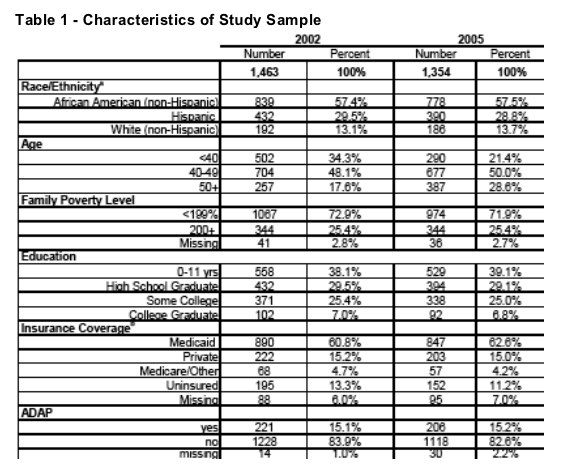
from Jules: in figure 1, African-Americans had higher percentage of not usin HAART although eligible in 2002 and 2005 compared to whites in al insurance categories but by big margins in several categories including Medicaid in 2002 & 2005, in private in 2002 & 2005, and in 2005 when uninsured. In 3 categories Hispanics are not using HAART although eligible compared to whites when they have Medicaid, medicare and uninsured, but not when they have private insurance. For whites in 200520% are eligible for HAART but not receiving it; for blacks 30% in Medicaid 44% in private, 32% in medicare, and 40% uninsured are eligible but not receiving HAART. For Hispanics, 28% in Medicaid, 8% with private, 33% in medicare, and 36% uninsured are eligible but not receiving HAART.
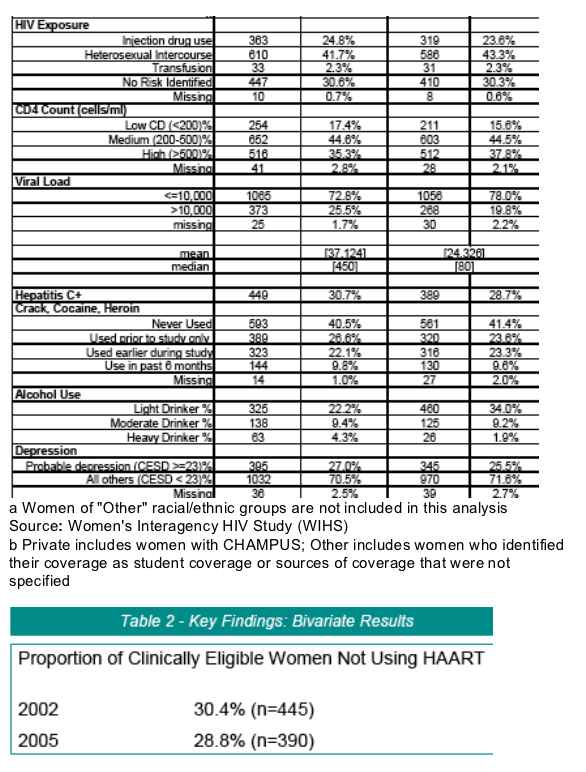
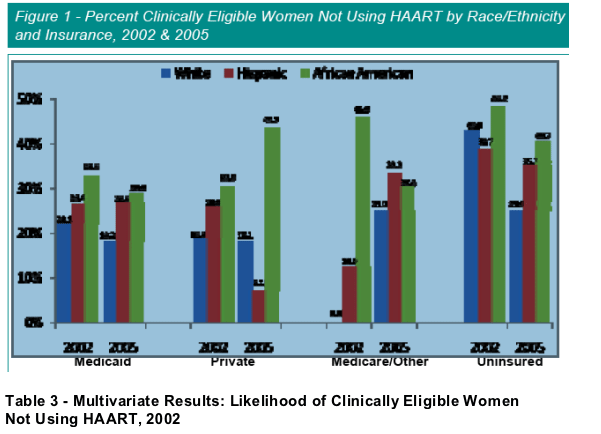
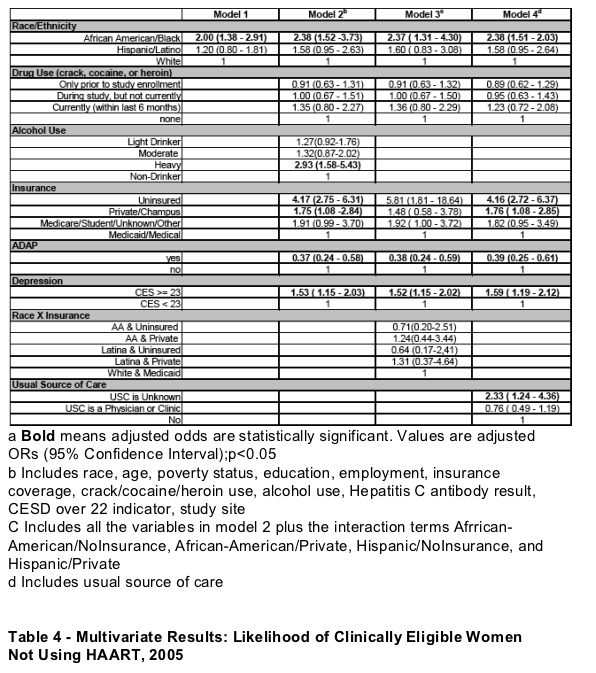
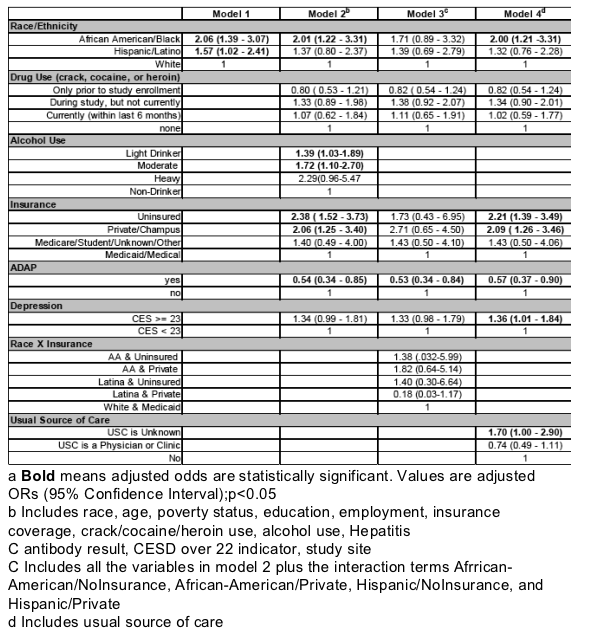
REFERENCES
1. Cohen MH, Cook JA, Grey DD, et al. Medically eligible women who do not use HAART: The importance of abuse, drug use, and race. AJPH, 2004 94(7):1147-1151
2. Cook JA, Grey DD, Burke-Miller JK, et al. Illicit drug use, depression, and their association with highly active antiretroviral therapy in HIV-positive women. Drug and Alcohol Dependence, 2007 89 (2007) 74-81
3. Cunningham WE, Mardson LW, Andersen RM, et al. Prevalence and predictors of highly active antiretroviral therapy use in patients with
HIV infection in the United States. J Acquired Immune Defic Syndr, 2000 25(2):115-123.
4. Kahn J, Haile B, Kates J, Chang S. Health and Federal Budgetary Effects of Increasing Access to Antiretroviral Medications for HIV by Expanding Mediciad. AJPH, 2001 91(9) 1464-1473
5. Keruly J, Convisor R, Moore R. Association of medical insurance with receipt of antiretroviral therapy. AJPH, 2002 92 (5) 852-857
6. Shapiro MF, Morton SC, McCaffrey D et al. Variations in the care of HIV-infected adults in the United States. JAMA 1999 281(24):2305-2315
|
| |
|
 |
 |
|
|